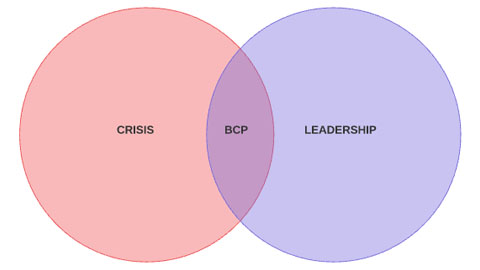It only takes a glance at today’s news to know that the world is in turmoil. At the moment, it’s COVID-19 sparking all the headlines and its effects are already being felt by businesses across the globe.
How prepared are you to handle crises like these? Our guide on crisis management will help you navigate through these times a little easier.
What is Crisis Management?
Companies face challenges each day, but certain scenarios can place the entity or its stakeholders at risk of harm. During those times it’s necessary to keep the company viable. Crisis management is the process of decision making and implementation with a focus on protecting the company’s future. Ensuring and keeping it functioning amid a predicament is paramount for the company’s survivability.
The Crisis Management Process
When a crisis takes place a CMP (crisis management plan) for the specific scenario needs to be compiled and approved. Take note: the management of a crisis actually starts before a situation is declared as being a crisis.
How does this work?
The role players (discussed in more detail below) need to be vigilant in order to identify signs of an approaching problem. This will give them more time to prepare for all possible outcomes.
Once the crisis hits, role players will:
- Determine the areas in the company that are affected
- Identify the impact on employees
- Make plan based on these realities
Both the team at large and the business’ service delivery must be prioritized in compiling a plan. The action plan must help guide the company through the tough times and ensure the business can continue well afterwards.
Types of Crises to Plan for
When everything is running smoothly it’s easy to forget that even the most successful companies are always at risk of experiencing disasters. Simply think of how a few tiny worms found in chocolate bars caused havoc for Cadbury in 2003. And then there’s the still evolving challenges that come with the Coronavirus pandemic, affecting business—and economies—on a global scale.
See? A crisis can come in any form. So, have you seriously considered plans for the following types of crises in your business plans?
- Financial crisis: An economic crisis could occur on a nationwide level or there may be a sudden dip in demand for a company’s products or services. Crisis management will be focused on managing cashflow in the short term and looking for new income streams for the long run. Bad management could also spark bankruptcy, which will call for drastic plans.
- Natural crisis: This could be a flood or tornado presenting physical threat to a building and your employees, or a drought which can impact certain industries.
- Personnel crisis: A single person in a company could affect public opinion and brand reputation if he or she has performed illegal acts that become public knowledge.
- Technological crisis: Companies rely on technology to perform tasks and serve customers. If something as simple as internet connection gets disrupted, sales, communications, and customer support are all affected.
You can see all of these crises aren’t common but you have no guarantee that you won’t face them. Also, some may be short lived while others—such as a flood or a health crisis—may have consequences that last for months. But why so much emphasis on something that’s not a reality yet?
Why is Crisis Management Important?
When managing a company there’s enough to keep you busy on a daily basis to ensure productivity and a healthy bottom line. Most of those tasks can be planned for and contingency plans are easy to put in place.
The hard truth is that all that could be for nothing if a crisis takes place. Depending on what you face, it could cripple your company if you don’t act wisely and timeously. That makes crisis management a non-negotiable for any business.
Similar to all aspects of your business, you need a plan and task allocation. So, who should be part of your crisis management team?
Important Roles in Crisis Management
It’s important to realize that your CMT (Crisis Management Team) is not a small responsibility you can pass to employees on your team with the least amount of work. Involvement from senior management is vital and they’ll partner with role players such as heads of departments.
The involvement of senior level team members is necessary because important decisions will have to be made if disaster strikes. The CMT must be able to make informed decisions so their knowledge of the company in general is essential. For this reason, your CMT should have individuals from the following groups in your company:
- Directors and executive team
- Human Resources
- IT and Asset Management
- Marketing and Sales and other essential profit-making departments
It’s important to realize that crisis management is the responsibility of a team, not an individual, because there are many different business aspects to manage and consider when disaster strikes. Each person on the CMT will have responsibilities. The following focus areas are usually covered:
- Human resources: Employees need to stay informed of company decisions and if they’ve undergone trauma, counseling may need to be organized. The crisis prevents staff from going to the office, alternate arrangements should be made.
- Security: Anything that affects the security of the company, its data or the premises need to be monitored.
- Health and safety: Even in crisis situations a company must align with health and safety regulations. Normal guidelines may need to be change. Operating on a different premises or increased health concerns—brought on by the crisis.
- Legal: Any new strategy or decision must align with legal guidelines. The legal team or person responsible for this aspect will have to consider all legal ramifications of the CMT’s decisions.
- Medical and healthcare: Health of everyone is impacted by the crisis, the team needs to consider how it impacts their decisions.
- Public relations, marketing and communication: You need to communicate to your audience, clients, shareholders and partners throughout the crisis period. This is essential to protect your brand reputation and to inform your audience about what they can expect from you.
- Administration and finance: An individual or team must take responsibility to ensure stability in terms of finances and cashflow.
- IT: With modern businesses relying on technology to fulfil many tasks, make sure someone focuses on setting up new networks. They might be damaged or affected by the crisis.
- Facilities: You must determine what the impact on your premises is and whether the area is safe to work in. New or temporary facility will have to be sourced if the existing one is damaged beyond use.
Leading this dynamic group of people will be the CMT leader who facilitates the process; he or she won’t necessarily carry the power to make final decisions. This is a group approach where role players inform each other of the realities of each department and how it will affect the company’s functioning. The team makes decisions and compiles a plan which offers the most benefits to the company and its people.
If there’s anything to be learned from recent world events, it is that proper crisis management is absolutely essential in corporate governance. While it may be easy to neglect in times of relative stability, this is not a lesson companies want to learn the hard way. As we get through this COVID-19 pandemic, take the time to review and improve your organization’s current crisis management or even a business continuity plan.
Jennie Chiu is a Business Development Manager and is part of Convene Asia’s team. Given her experience working before in the BFSI industry, she has gained extensive knowledge in crisis management and business continuity. Jennie eagerly shares information on crafting strategies to help businesses thrive in the digital age.









